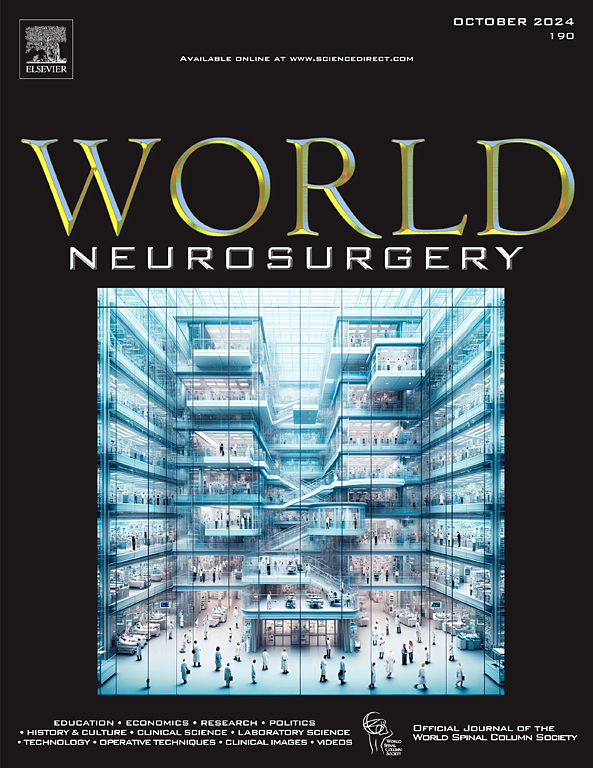隐匿性脊髓栓系综合征和终丝脂肪瘤的组织学特征
IF 1.9
4区 医学
Q3 CLINICAL NEUROLOGY
引用次数: 0
摘要
脊髓栓系综合征是一种以脊髓病理性栓系为特征的神经系统疾病,可导致神经系统、泌尿系统和骨科功能障碍。隐匿性脊髓栓系综合征(OTCS)表现出类似的临床表现,但缺乏明确的影像学证据,而终末丝脂肪瘤(FTL)涉及终末丝脂肪浸润,导致脊柱牵拉。在这些情况下,终丝的组织病理学特征仍不完全清楚。目的探讨OTCS和FTL的终末纤维组织学特征。方法采集2020年4月~ 2024年4月行手术解栓的17例OTCS患者和22例FTL患者的终丝标本,并采集6具尸体作为参考样本。组织病理学评价包括苏木精-伊红染色、马松三色染色和弹性范吉森染色。免疫组织化学评估I型和III型胶原。结果sotcs患者表现为ⅰ型胶原减少,弹性纤维稀疏且不规则,毛细血管扩张,透明样变性。FTL标本显示脂肪浸润,弹性纤维密集堆积和拉长,强烈的I型胶原染色,尽管有些标本显示弹性降低。尸体标本显示组织学正常,无变性。结论ocs中I型胶原蛋白和弹性纤维减少,提示终丝弹性受损,可能导致病理性系栓。在FTL中,脂肪浸润是驱动脊髓牵拉的主要因素,尽管一些病例也显示弹性纤维完整性降低。这些发现强调了进一步研究组织病理变化与临床表现之间关系的重要性。更好地理解这种相关性对于制定标准化管理战略至关重要。本文章由计算机程序翻译,如有差异,请以英文原文为准。

Histological Characteristics of the Filum Terminale in Occult Tethered Cord Syndrome and Filum Terminale Lipoma
Background
Tethered spinal cord syndrome is a neurological disorder characterized by pathological tethering of the spinal cord, leading to neurological, urological, and orthopedic dysfunction. Occult tethered cord syndrome (OTCS) presents with similar clinical manifestations but lacks definitive radiological evidence, whereas filum terminale lipoma (FTL) involves adipose infiltration of the filum terminale, contributing to spinal traction. The histopathological characteristics of the filum terminale in these conditions remain incompletely understood.
Objective
To characterize the histological features of the filum terminale in OTCS and FTL.
Methods
Filum terminale specimens were obtained from 17 patients with OTCS and 22 patients with FTL undergoing surgical untethering (April 2020–April 2024) and from six cadavers as reference samples. The histopathological evaluation included hematoxylin-eosin, Masson trichrome, and Elastica van Gieson staining. Immunohistochemistry assessed collagen types I and III.
Results
OTCS cases showed reduced collagen type I, sparse and irregularly looped elastic fibers, capillary dilation, and hyaline-like degeneration. FTL specimens exhibited adipose infiltration, densely packed and elongated elastic fibers, and intense collagen type I staining, although some showed reduced elasticity. Cadaveric samples displayed normal histology without degeneration.
Conclusions
The observed decrease in collagen type I and elastic fibers in OTCS suggests compromised filum terminale elasticity, potentially contributing to pathological tethering. In FTL, adipose infiltration is the primary factor driving spinal cord traction, although some cases also showed reduced elastic fiber integrity. These findings emphasize the importance of further research into the relationship between histopathological changes and clinical presentations. Better understanding of this correlation is crucial for developing standardized management strategies.
求助全文
通过发布文献求助,成功后即可免费获取论文全文。
去求助
来源期刊

World neurosurgery
CLINICAL NEUROLOGY-SURGERY
CiteScore
3.90
自引率
15.00%
发文量
1765
审稿时长
47 days
期刊介绍:
World Neurosurgery has an open access mirror journal World Neurosurgery: X, sharing the same aims and scope, editorial team, submission system and rigorous peer review.
The journal''s mission is to:
-To provide a first-class international forum and a 2-way conduit for dialogue that is relevant to neurosurgeons and providers who care for neurosurgery patients. The categories of the exchanged information include clinical and basic science, as well as global information that provide social, political, educational, economic, cultural or societal insights and knowledge that are of significance and relevance to worldwide neurosurgery patient care.
-To act as a primary intellectual catalyst for the stimulation of creativity, the creation of new knowledge, and the enhancement of quality neurosurgical care worldwide.
-To provide a forum for communication that enriches the lives of all neurosurgeons and their colleagues; and, in so doing, enriches the lives of their patients.
Topics to be addressed in World Neurosurgery include: EDUCATION, ECONOMICS, RESEARCH, POLITICS, HISTORY, CULTURE, CLINICAL SCIENCE, LABORATORY SCIENCE, TECHNOLOGY, OPERATIVE TECHNIQUES, CLINICAL IMAGES, VIDEOS
 求助内容:
求助内容: 应助结果提醒方式:
应助结果提醒方式:


